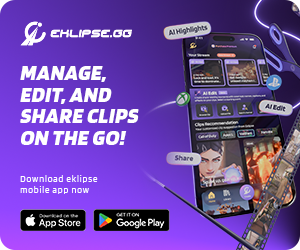
Level Up Your Marvel Rivals Gameplay
Capture your epic wins, clutch moments, and even hilarious fails with Eklipse. Easily create and share highlight reels with your friends—even if you're not streaming!
Learn MoreIn the previous article, we’ve already discussed Twitch vs YouTube, which is actually quite tough when it comes to the right choice. Well now, it’s time to see the battle of YouTube vs TikTok stream.
As we know that TikTok has become one of the most popular sharing platforms nowadays, especially among younger users. Due to this fact, no wonder that TikTok is now competing with YouTube which has been popular since 2005.
Due to the high number of users, many people made both platforms the mine of opportunity. Everyone can start making money through these platforms. But which one is right for you? YouTube or TikTok? Worry no more, since we’re going to figure it out through this post. Let’s go!
TikTok vs YouTube: Key Differences
The best platform for you depends on your goals, target audience, and content style. Experiment with both YouTube and TikTok, but prioritize what resonates most with your viewers. Before you decide definitively, here are the key differences between TikTok and YouTube that you should know.
Who’s Watching?
- YouTube: A wide audience enjoys everything from short clips to in-depth documentaries.
- TikTok: Primarily attracts Gen Z, but its reach is expanding. It’s a hub for trendy, viral content.
Content Creation:
- YouTube: Offers flexibility, with live streams, premieres, Shorts, and a reputation for high-quality content.
- TikTok: Focuses on short, engaging videos with easy editing tools and a focus on storytelling.
Building a Community:
- YouTube: Encourages interaction with comments, live chats, and personalized recommendations.
- TikTok: Prioritizes engagement with features like duets, the For You Page, and high content visibility.
Monetization Options:
- YouTube: Provides various ways to make money, including diverse ad formats for businesses.
- TikTok: Offers immersive ad experiences and opportunities for sponsored hashtag challenges.
On a final note:
Both platforms offer unique advantages for businesses. Consider your goals, target audience, and content style to choose the best fit. Don’t be afraid to experiment and adapt your strategy for each platform.
Now that we’ve established this, let’s delve into a more detailed explanation.
1. YouTube vs TikTok Stream Monetization

When discussing YouTube and TikTok, the focus often lies on how they can impact business engagement. Let’s start with YouTube first.
To generate revenue from YouTube content, creators need to be eligible to place ads within their videos. YouTube demonstrates its appreciation for its creators by offering a generous 55% share of its ad revenue. This translated to over $15 billion in payments to creators last year alone. In addition to AdSense, creators can also earn income through affiliate marketing, influencer marketing, and by leveraging Super Chat and Super Stickers.
On TikTok, generating revenue can be slightly easier compared to YouTube. Here, promoting brands and participating in affiliate marketing are prominent strategies. However, it’s crucial to have a sizable following and viewership established through your content first.
2. Ad Format Variety

Speaking of ads, both YouTube and TikTok offer different types of ads. Understanding these ad types is crucial for supporting your goals. On YouTube, consider using skippable in-stream ads to increase sales and leads. For increasing brand awareness and reach, bumper ads are a good option. It’s worth noting that your ad format choice can significantly impact how you connect with your audience.
TikTok also offers several ad formats to help generate revenue. The first is the In-Feed ad, which appears and auto-plays on a user’s For You Page (FYP). Brand Takeover ads are another option, but users cannot like or comment on them. Additionally, you can leverage Hashtag Challenges and Branded Lenses in your marketing strategy.
3. Audience Reach and Engagement

The second factor to consider when choosing the right platform between YouTube and TikTok for business is audience engagement. According to data, YouTube captures 25% of all mobile traffic. Additionally, a staggering 95% of the global internet population accesses videos on this platform.
With this massive reach, YouTube can help you engage with a broader audience, increasing your chances of growing your career as a content creator there.
On the other hand, TikTok boasts a diverse user base, with Gen Zs making up 41% of the platform’s population. Millennials, Gen Xs, and baby boomers comprise the remaining user base. While Gen Zs may be the primary target for advertisers, there’s also a chance to reach a wide range of niche communities and age groups.
4 YouTube vs TikTok Algorithm
Now, let’s delve into the algorithms. Both YouTube and TikTok recommend content based on audience interest. TikTok prioritizes videos on someone’s FYP (For You Page) based on the content they previously enjoyed or interacted with.
The YouTube algorithm functions similarly to TikTok’s. However, YouTube also factors in view duration, user satisfaction with previously watched videos, and external elements like seasonal relevance and competition.
Ultimately, both algorithms ensure users discover content that resonates with them.
5. TikTok Stream vs YouTube Video Type

The content format differences are clear. YouTube focuses on long-form videos, ranging from 15 minutes to 12 hours in duration. TikTok, on the other hand, specializes in bite-sized, vertical videos with a maximum length of 10 minutes.
When it comes to content type, TikTok thrives on short-form content, often featuring fun and humorous elements like dance videos, pranks, short tutorials, lip-syncing, or mini vlogs.
YouTube offers a wider content arsenal. You can find review videos, game streams, reaction videos, tutorials, vlogs, and much more. Tone also varies, with content ranging from formal and casual to lighthearted and even serious. This diversity makes YouTube more flexible for content creation.
However, before producing a YouTube video, ensure you have a good setup for recording and editing. High editing skills and compatible software are often recommended. Conversely, TikTok offers all-in-one features for recording and editing videos, sometimes eliminating the need for separate editing software.
YouTube vs. TikTok: A Battle of Features
While both YouTube and TikTok are video-based platforms, they cater to different content styles and user experiences. Here’s a breakdown focusing on the apps themselves:
YouTube
Pros:
- A Wide Range of Content Types: Supports everything from short clips (YouTube Shorts) to long-form documentaries, vlogs, live streams, and even movies.
- Advanced Features: Offers features like premieres, live chat, end screens, cards, and playlists for enhanced audience engagement.
- Detailed Analytics: Provides creators with in-depth data on video performance, demographics, and audience engagement.
- Strong Search Engine Optimization: Videos can rank well in search results, driving organic traffic.
- Monetization Powerhouse: Established monetization options like ads, sponsorships, and merchandise sales.
Cons:
- Potential for Copyright Issues: Strict copyright laws can make it challenging to use copyrighted music or content.
- High Production Barrier: Creating high-quality videos often requires investment in equipment and editing skills.
- Algorithm Focus on Watch Time: Videos need to be engaging enough to keep viewers watching for longer to rank higher.
TikTok
Pros:
- Simple and User-Friendly: Easy to use for creating and editing short-form videos with built-in tools and effects.
- Discovery Power: The “For You Page” algorithm excels at promoting viral content, reaching a wider audience.
- Engaging Features: Duets, challenges, stitches, reactions, and live streams foster high user engagement and interaction.
- Trend-Driven Content: Capitalize on the latest trends and challenges to gain traction quickly.
- Immersive Advertising: Offers innovative ad formats like interactive in-feed ads and sponsored hashtag challenges.
Cons:
- Limited Content-Length: Not ideal for in-depth tutorials or complex topics.
- Focus on Entertainment: May not be suitable for all types of businesses or educational content.
- Fast-Paced Trends: Keeping up with the latest trends can be time-consuming and demanding.
How to Choose the Right Tool?
When it comes to video content, both YouTube and TikTok excel in different areas. YouTube caters to a wider range of content types, while TikTok thrives on short-form, trend-driven content creation with high engagement potential.
Consider your content goals and target audience to choose the platform that best suits your needs. You can even leverage both platforms for a comprehensive video strategy!
Final Thoughts
In conclusion, the battle between YouTube and TikTok isn’t a clear-cut one. The best platform depends on your brand’s marketing goals and target audience. If you’re targeting a younger crowd, TikTok might be ideal, while YouTube provides a broader reach across content styles. Consider factors like monetization, brand tone, and the editing resources available.
We hope this breakdown of YouTube vs. TikTok has been helpful. Don’t forget to check out our previous article for a deeper dive into YouTube Shorts, another player in the short-form video space.
For those needing powerful yet user-friendly editing tools to create captivating video content, look no further than Eklipse! Eklipse offers a free tier that lets you experiment with its advanced features, making it a perfect starting point for both beginners and seasoned creators.

🎮 Play. Clip. Share.
You don’t need to be a streamer to create amazing gaming clips.
Let Eklipse AI auto-detect your best moments and turn them into epic highlights!
Limited free clips available. Don't miss out!
